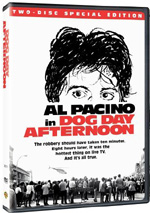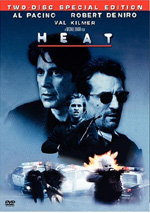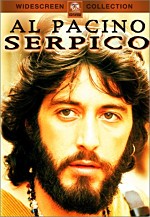|
WARNER
|

| |
|
MOVIE INFO
|
|
Director:
Sidney Lumet
Cast:
Al Pacino, John Cazale, Charles Durning, James Broderick, Beulah Garrick, Chris Sarandon, Sully Boyar
Writing Credits:
P.F. Kluge (article), Thomas Moore (article), Frank Pierson
Tagline:
The robbery should have taken 10 minutes. 4 hours later, the bank was like a circus sideshow. 8 hours later, it was the hottest thing on live T.V. 12 hours later, it was all history. And it's all true.
Synopsis:
Al Pacino plays a ferocious and fed-up bank robber in Lumet's classic film Dog Dat Afternoon. Balancing suspense, violence, and humor, the film's depiction of a grand-scale media event craftily dives from the political to the personal, evoking a piercing portrait of a man and his devastating downward tumble as seen through the media circus that Lumet made a career of chronicling. Pacino is heartbreakingly real as Sonny, a smart yet self-destructive Brooklyn tough whose plan to rob the local bank to fund his male lover's (Chris Sarandon) sex change goes absurdly wrong. Accompanied only by his doltish accomplice, Sal (John Cazale), Sonny realizes that all the money had been removed before his arrival, and decides to kidnap a handful of bank employees instead. As the lengthy August day drags on, Sonny and hordes of local police, led by Sergeant Moretti (Charles Durning), make little progress, and eventually Sonny's wife and lover are brought to the scene. The crowd's sympathy is immediately captured by the charismatic Sonny, whose antagonism with the police is played out before an audience of millions, leading to an inevitably tragic finish.
Box Office:
Domestic Gross
$46.665 million.
MPAA:
Rated R
| |
|
DVD DETAILS
|
Presentation:
Widescreen 1.85:1/16x9
Audio:
English Monaural
French Monaural
Subtitles:
English
Spanish
French
Closed-captioned
Runtime: 121 min.
Price: $26.98
Release Date: 2/28/2006
Bonus:
Disc One
• Audio Commentary with Director Sidney Lumet
• Trailer
Disc Two
• ďThe Making of Dog Day AfternoonĒ Documentary
• ďLumet: Film MakerĒ Vintage Featurette
| |
|
PURCHASE @ AMAZON.COM
|

| |
|
EQUIPMENT
|
Sony 36" WEGA KV-36FS12 Monitor; Sony DA333ES Processor/Receiver; Panasonic CV-50 DVD Player using component outputs; Michael Green Revolution Cinema 6i Speakers (all five); Sony SA-WM40 Subwoofer.
| |
|
RELATED REVIEWS
|


| |
|
Dog Day Afternoon: Special Edition (1975)
|
|
Reviewed by Colin Jacobson (February 14, 2006)
Film buffs like to look at 1939 as the greatest single year in movie history, but 1975 wasnít exactly a cheesefest itself. Examine that yearís five Best Picture nominees and youíll find five classics. In addition to eventual winner One Flew Over the Cuckooís Nest, we find four others that easily could have taken home the Big Prize: personal favorite Jaws, Stanley Kubrickís understated Barry Lyndon, Robert Altmanís seminal Nashville and Sidney Lumetís edgy Dog Day Afternoon.
As an aside, 1976 was another stellar year. Rocky won the Oscar that year though it was arguably the weakest of the five nominees. It went up against my personal pick All the Presidentís Men, Bound for Glory, Network and Taxi Driver. Take the 10 nominees from 1975 and 1976 and they easily top the 10 options from 1939. I doubt thereís ever been a one-two punch like 1975/1976 in the history of movies.
Based on events that took place on August 22, 1972, Dog Day Afternoon introduces us to would-be bank robbers Sonny (Al Pacino), Sal (John Cazale) and Stevie (Gary Springer). Almost immediately after they announce their intentions at the bank, Stevie chickens out and departs. That leaves ringleader Sonny and slow-witted Sal on their own, and other problems immediately occur.
While Sonny planned a quick grab and run, matters conspire to keep them there long enough for the authorities to arrive. This changes their robbery into a hostage situation. The movie follows the various interactions as we watch how Sonny deals with the events and tries to succeed.
I hate to be someone who laments how they donít make Ďem like they used to, but in the case of the Seventies, thatís true. Movies enjoyed a brief period where edgy and unconventional was the norm. (HmmÖ is that an oxymoron?) Films could be tougher and more no-nonsense, and thatís the tone that makes Dog effective.
With its matter-of-fact depiction of events, one becomes tempted to call Dog ďdocumentary-styleĒ, but thatís not really the case. We never feel like weíre watching real-life filmed, and thatís a good thing. Dog offers enough verisimilitude to make it work, but it doesnít rely on the cheap crutches of most documentary-style films. Those can sacrifice careful pacing and camerawork in an attempt to seem ďrealĒ, but they often fail.
Instead, Dog - like All the Presidentís Men - prefers a simple tone that avoids overwrought melodrama. Thereís more than enough drama on screen to make the events interesting. The filmmakers donít need to goose that with theatrics or hysterics.
In the face of the material, director Sidney Lumetís restraint seems all the more admirable. The film offers many chances for events to become grandiose or over the top, but Lumet keeps them down to earth. That choice makes the movie more effecting and involving. It doesnít shout at us to take notice of it. Instead, it draws us in with the basics.
Dog comes from the era in which Al Pacino still knew how to act. Iíd hate to see him try to play a character like Sonny today, as Iím sure Pacino would offer little more than bluster and bombast. Thereís a smidgen of that in his performance, but not much, and he connects to Sonnyís conflicted soul. Pacino avoids easy choices to evoke our sympathy.
In his short but remarkable career, Cazale often played not-too-intelligent characters. He remains best known as Fredo from the first two Godfather flicks, and his role in The Deer Hunter wasnít exactly a genius. To his credit, Cazale always spun these parts to make them different, and thatís what he did with Sal. An underwritten role, Cazale makes the most of his quiet scenes and turns the character into something memorable.
All of that goes for Dog Day Afternoon itself. It takes dramatic events and depicts them in a wonderfully understated way. It could have gone with absurdity and overwrought excess, but it preferred to let the material speak for itself.
Footnote: itís clear that Bill Murray and the others behind 1990ís marvelous Quick Change studied Dog Day Afternoon. The formerís bank robbery sequence pays homage to Day on many occasions. I couldnít suppress a smile when I saw each connection between the two.
|
The DVD Grades: Picture B/ Audio B-/ Bonus B
|
|
Dog Day Afternoon appears in an aspect ratio of approximately 1.85:1 on this single-sided, double-layered DVD; the image has been enhanced for 16X9 televisions. Though the picture never transcended the limitations of its era, it held up pretty well.
For the most part, sharpness seemed solid. Occasional shots demonstrated minor softness, but those never caused significant distractions. The majority of the movie showed good clarity and delineation. Jagged edges and shimmering seemed non-existent, and only a sliver of edge enhancement appeared. In addition to some unavoidable natural grain, a few source flaws materialized. I noticed a smattering of specks and marks. These were prominent only a couple of times during the movie, as they popped up infrequently the rest of the time.
Colors went with a natural palette that came across well. The interior shots were appropriately subdued, but exteriors showed quite vivid tones. Across the board, colors looked clean and concise. Blacks were appropriately dark and dense, while shadows seemed adequate to good. Some of the bank shots could be a little dim, but they usually were smooth. Overall, this was a more than satisfying transfer.
In a similar vein, the monaural soundtrack of Dog Day Afternoon was perfectly fine. Speech played the most important role. A smidgen of edginess occurred, but not as much as I expected, and the lines were mostly positive. They could be somewhat dull, but intelligibility was very good.
Effects came from environmental elements. Some louder bits occurred due to helicopters, planes and other vehicles, but since so much of the flick took place in the bank, we didnít get much. They were clear and reasonably accurate. Music popped up only during the opening credits, at which time Elton Johnís ďAmoreenaĒ played. The song displayed surprisingly good clarity and definition. Ultimately, the audio worked well for this movie.
One footnote about the audio: during his audio commentary, Sidney Lumet makes reference to stereo sound for the film. Maybe I misunderstood, but this gave me the impression the movie originally came with that audio. However, I can find no evidence it ever appeared in stereo, and it looks like all the home video versions have been mono.
When we move to the DVDís extras, Disc One includes the filmís theatrical trailer and an audio commentary from director Sidney Lumet. He presents a running, screen-specific piece. Lumet discusses the movieís lack of score and the inclusion of the Elton John song, cast, characters and improvisation, sets and locations, the movieís naturalism and verisimilitude, and general thoughts about his work here and elsewhere.
In addition to the basic data, Lumet offers a number of nice insights such as a comparison of LA extras vs. NY extras. I especially like Lumetís thoughts on working with Pacino and the actorís tendencies. Thereís also less dead air here than during other Lumet commentaries; he still drags at times, but usually he keeps things moving. The commentary provides a very solid look at the film and its connected issues.
Over on Disc Two, the main component comes from the four-part The Making of Dog Day Afternoon. Taken together, the four chapters fill 57 minutes and 15 seconds. These offer the usual mix of movie clips, archival materials, and interviews. We find notes from Lumet, producer Martin Bregman, screenwriter Frank Pierson, editor Dede Allen, director of photography Victor J. Kemper, assistant director Burtt Harris, and actors Al Pacino, Charles Durning, Lance Henriksen, and Chris Sarandon.
We start with notes on how the true story was adapted for the screen and related choices, rehearsals and their effect on the script, casting and performances. From there we move through logistics of the locations, realism and photography, specifics of some scenes and characters, editing and pacing, and reactions to the film.
Some documentaries do little more than echo audio commentaries, but happily, this one greatly expands on Lumetís chat. Inevitably, some repetition occurs, but not enough to become tedious. It covers the facets of the production with candor, especially when we hear from Pierson. He offers terrific insights into his choices for the script, and Pacino also aptly conveys his original doubts and concerns about aspects of the film. The show gives us many fine details and fleshes out our understanding of the film well.
The set ends with a vintage featurette called Lumet: Film Maker. This nine-minute and 59-second piece shows shots from the set and interviews with Lumet, vehicle supplier George Santana, boom man Bob Rogow, actor Carmine Foresta, and still photographer Muky Muncasi. We get some quick notes about Lumetís working style and hear from the director himself about various production details. We learn most of this elsewhere, so ďFilm MakerĒ is moderately interesting just for some of the archival footage.
Gritty and blunt, Dog Day Afternoon offers an unusual bank robbery flick. It goes down unexpected paths and benefits from a frank, restrained tone. The DVD presents pretty good picture and audio along with a couple of very informative extras. I definitely recommend this effective movie.
|
|
Viewer Film Ratings: 4.6944 Stars | Number of Votes: 36 |
|
|

